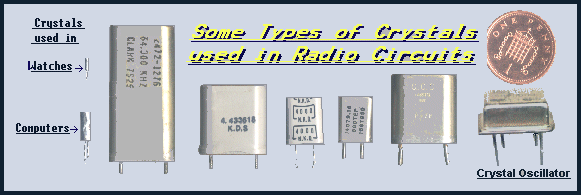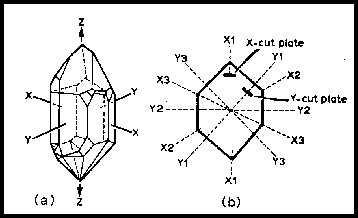
A quartz crystal is a very thin slice of quartz which has been cut from a large, naturally occurring crystal of quartz. Quartz exhibits the 'piezo-electric' effect, ie a mechanical strain applied to a suitably cut piece of quartz causes an electric stress to be set up between opposite faces of the piece. This 'piezo electric' effect is often used in gas ring igniters, and gas cigarette lighters. Conversely an electric stress applied between opposite faces of the piece causes a mechanical deformation. The frequency of resonance of this mechanical deformation depends upon the dimensions of the slice and the mode of vibration; other properties (eg temperature coefficient) depend upon the orientation of the slice with reference to an axis of the natural crystal.
Crystals can operate up to a frequency of about 22MHz in the fundamental mode and up to about 200MHz in the appropriate circuit in what is known as the 'overtone' mode. Overtone operation occurs at frequencies close to the odd multiples of the fundamental frequency.
Crystals for frequencies below about 1 MHz are generally in the form of a bar rather than a thin slice; at 20kHz, for example, this bar is about 70mm long.
Connections to the modern crystal are made to electrodes of gold or silver which are deposited on opposite faces of the crystal. These connections also support the crystal, which is then hermetically sealed in an evacuated glass envelope or a small cold-welded metal container.

The above photo includes a variety of commonly seen crystal (or XTAL) packages.

Fig 2.19. (a) Double-terminated natural quartz crystal Indicating relationship between X Y and Z axes The crystal usually has one pyramidal termination and a rough end where it has broken from the parent rock (b) Various X and Y axes as viewed along a direction parallel to the Z axis and examples of positions of X-cut and Y-cut plates
The frequency of a crystal can be changed or 'pulled' by a few kilohertz by variation of capacitance in parallel with it (a varactor diode or a variable capacitor). Quartz crystals form the basic building block of accurate oscillators, on which the stability and accuracy of modern transmitters, receivers as well as wrist watches depend.
The quartz crystal is equivalent to a very high Q tuned circuit and so can be substituted for the tuned circuit in an oscillator (see Chapter 3). Crystals are also used in pairs in band-pass filters.